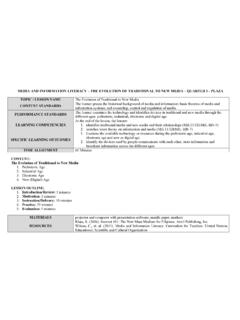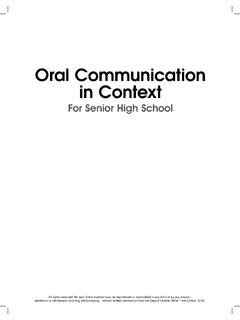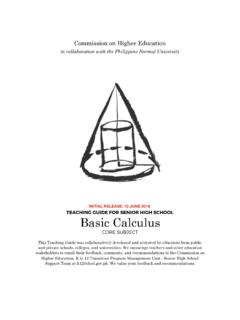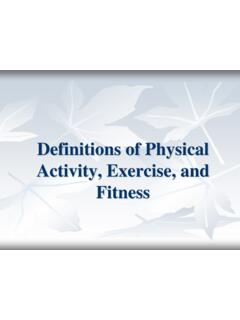Transcription of SENIOR HIGH SCHOOL CORE SUBJECT | HEALTH OPTIMIZING ...
1 SENIOR HIGH SCHOOL CORE SUBJECT | HEALTH OPTIMIZING PHYSICAL EDUCATION ( 1 and 2) QUARTER ONE GRADE 11 Page 1 of 8 TOPIC / LESSON NAME Exercise for fitness CONTENT STANDARDS The learner demonstrates understanding of fitness and exercise in OPTIMIZING one s HEALTH as a habit; as requisite for physical activity performance, and as a career opportunity PERFORMANCE STANDARDS The learner leads fitness events with proficiency and confidence resulting in independent pursuit and in influencing others positively LEARNING COMPETENCIES 1. Distinguishes aerobic from muscle and bone-strengthening activities (PEH11FH-Ia-1) 2. Engages in moderate to vigorous physical activities (MVPAs) for at least 60 minutes most days of the week in a variety of settings in- and out-of SCHOOL (PEH11FH-Ia-t-8) 3.
2 Demonstrates proper etiquette and safety in the use of facilities and equipment (PEH11FH-Ia-t-12) SPECIFIC LEARNING OUTCOMES At the end of the lesson, the learners will be able to: 1. Explain, in writing, the difference between aerobic from muscle and bone-strengthening activities 2. Categorize/classify a list of activities into aerobic, muscle strengthening or bone-strengthening 3. Make an honest inventory of one s monthly moderate to vigorous physical activities TIME ALLOTMENT 120 minutes (2 meetings) HEALTH OPTIMIZING PHYSICAL EDUCATION ( 1 and 2) is given 120 minutes per week LESSON OUTLINE: 1st Meeting: 1. Introduction/Review: Introducing of Classroom Policies (15 minutes); Communicating learning objectives (5 minutes) 2. Motivation: Exhaust Game (5 minutes) 3.
3 Instruction: Lecture and discussion (30 minutes); Exit pass (5 minutes) 2nd Meeting 4. Review: (5 minutes) 5. Practice (35 minutes) 6. Evaluation (20 minutes) 7. Enrichment: Exercise Log (out-of- SCHOOL activity) MATERIALS RESOURCES Lesson 6: Planning for Physical Activities, Grade 11 Active Healthy Lifestyles Manitoba Government, Canada < >. Accessed: 4 January 2016 Make the Most of the First Day of Class Loosely based on Lyons et al. 2003 Carnegie Mellon University, < >. Accessed: 5 January 2016 Nike Training Club < > Accessed: 5 January 2016 Physical Education, Grade 7 Learner s Manual Department of Education, Philippines SENIOR HIGH SCHOOL CORE SUBJECT | HEALTH OPTIMIZING PHYSICAL EDUCATION ( 1 and 2) QUARTER ONE GRADE 11 Page 2 of 8 PROCEDURE MEETING LEARNERS NEEDS INTRODUCTION (20 minutes) 1.
4 Introduce yourself to the class 2. Present and clarify the course s learning objectives 3. Help students learn about each other 4. Set the tone for the course. You are encouraged to show your students the course schedule. 5. Collect baseline data on students knowledge and motivation on the course 6. Stir students interest for the course content 7. Inform students of course requirements The importance of the First Day of Class: Since this is the first day of class, it is strongly recommended that a few minutes is invested on proper introduction, levelling of expectations and getting a sense of who your learners are (prior knowledge and motivation) Review of the Junior High SCHOOL PE Curriculum: To understand where the students are coming from, review the JHS PE curriculum available for viewing and download at the DepEd Website MOTIVATION (5 minutes) 1.
5 Tell the students to get their notebooks. 2. Instruct them to describe what physical fitness is, using their own words. Writer their answers on their notebooks. Sample question: In your own understanding, what is physical fitness ? Physical fitness For me, physical fitness is Room for differentiation: If students find the previous question too challenging, do any of the ff: a) Describe a person who is physically fit. How do you know that a person is physically fit? What can he do? What does he eat? b) You may also ask them to react to this quote by Jim Rohn Take care of your body, it is the only place you have to live. c) Or ask your students What comes to your mind when you see/hear/read Physical fitness ? Sample responses for option C exercise, sports body, well-being, HEALTH kalusugan food, diet thin, fat, sexy lifestyle katawan 3.
6 Think-pair-share: Tell the students to find a partner, preferably their seatmate for convenience, and share their answers. Debunking myths and assumptions: Be ready with answers such as Thinness is equated with healthiness or those who maintain a vegan diet is automatically healthier than those who don t. Consider choice of words: Words such as thin or fat may be used in class. This may be an opportunity for discrimination. Be ready to infuse values on respect. SENIOR HIGH SCHOOL CORE SUBJECT | HEALTH OPTIMIZING PHYSICAL EDUCATION ( 1 and 2) QUARTER ONE GRADE 11 Page 3 of 8 INSTRUCTION (30 minutes) 1. Post on the board the following definitions of Physical fitness : a) Physical fitness is a state of good HEALTH and well-being of an individual (K to 12 Grades 1 to 10 Curriculum, Glossary of Terms) b) Physical fitness is a set of abilities that one possesses in order to perform physical activities.
7 (Centers for Disease and Prevention, 1985; Grade 7 Teacher s Guide Session 1, Module 1) 2. Process your students responses from the motivation activity. Connect it with the definition of physical fitness . 3. Transition to the three components of physical fitness . Recall and review the three components of fitness by posting the definitions on the board. Call students to match the definitions with the corresponding component . a) HEALTH -related physical fitness ( HRPF) consists of specific components that have a relationship with good HEALTH , or a lower risk of illness. HRPF includes: body composition, cardiovascular endurance, flexibility, muscular endurance and muscle strength b) Skill-related physical fitness (SRPF) pertains to components related with learning motor skills quickly and ability to achieve high level of performance in sports.
8 SRPF includes: agility, balance, coordination, power, reaction time and speed c) Physiological fitness relates to biological systems that are influenced by one s level of habitual physical activity Physiological fitness includes: Metabolic fitness (MetF), Morphological fitness (MorF) and bone integrity (BI) Source: Grade 7 Learner s Material, DepEd 4. Emphasize that as humans, we have the power to shape and influence our physical fitness . The three components of physical fitness can be directly affected by our diet (what we eat) and the amount of physical activity we do. Review: The topics for the lesson were already introduced during JHS (Grade 7 and 8). It is assumed that this is just a review for the students.
9 For Participation Purposes: Encourage your students to revisit their Junior High SCHOOL notes. You can also ask them to bring their notes from Junior High SCHOOL to class Again, this is just a review of their JHS lessons. For visual purposes: it would help to have an instructional material for the components of fitness . ( chart, chalk work, hand-outs, etc) SENIOR HIGH SCHOOL CORE SUBJECT | HEALTH OPTIMIZING PHYSICAL EDUCATION ( 1 and 2) QUARTER ONE GRADE 11 Page 4 of 8 5. EXHAUST ACTIVITY: After knowing the components of physical fitness , it is now time to reflect on one s fitness . In two minutes, instruct the students to write all the physical activities that they perform regularly Sample responses washing the dishes walking to SCHOOL lifting weights sweeping the floor watering the plants playing sports ironing the clothes fetching a pail water dancing 6.
10 Discuss what physical activities are: a) Any bodily activity that enhances or maintains physical fitness , HEALTH and wellness b) Any bodily movement produced by skeletal muscles that requires energy expenditure 7. Inform the students that you would be referring to their answers in the latter part of the period 8. Go on to review the types of physical activities. Ask your students for the three types of physical activities. You may also post them on the board. Aerobic Muscle-strengthening Bone-strengthening 9. Tell your students to refer to their answers in #5 (Exhaust Activity). On their notebooks, instruct them to categorize their answers into aerobic, muscle-strengthening and bone-strengthening, based on their previous knowledge.












